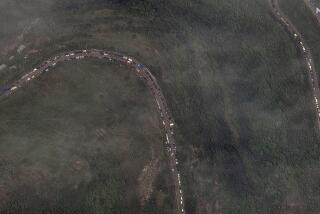Fabled Silk Road Revives After Long Intermission : Central Asia: The trade route that linked Europe and the East went into decline 500 years ago. But the Soviet collapse gave it a new lease on life.
- Share via
KHORGOS, on the China-Kazakhstan border — If the Silk Road traders of 2,000 years ago were to guide their camel caravans into the bustling new bazaars here, it wouldn’t take them long to cut a deal.
The Chinese stereos, Korean televisions and Japanese cameras might baffle them, but they wouldn’t miss a beat haggling over Oriental carpets, Iranian fruit and Indian sandals.
They’d soon sniff out the value of the Russian vodka, French blue jeans, counterfeit American dollars and illicit drugs, all of which began to flow when this isolated frontier was unsealed three years ago.
After an intermission that lasted centuries, the Silk Road has been reborn in the cities and towns that dot the plains of Central Asia, a region starved of consumer goods and relegated to drab, dreary poverty during Soviet rule.
“Until four years ago, no one went to the bazaars. It was only for secondhand goods,” said Yershad Israelilov, a 27-year-old Kazakh trader who was quick to capitalize when borders were thrown open after the Soviet collapse in 1991.
“Now,” he said, “our whole life is a bazaar.”
Khorgos, a small farming town in urgent need of a fresh coat of paint, was such a backwater that it didn’t appear on many Soviet maps. And for good reason. Almost no one was allowed to use it to cross the tense Soviet-Chinese boundary.
But with Kazakhstan’s independence, Khorgos suddenly emerged as the main overland trading route of the revived Silk Road, bringing a flood of Chinese goods and hints of prosperity to a long-depressed region.
Set against a chain of snowcapped mountains, the new Chinese Market has hundreds of small traders offering imported goods in the Kazakh town of Zharkent (formerly Panfilov), 20 miles from the border.
Such trading outposts marked the original Silk Road, which emerged in the 2nd Century BC as a network of routes that crisscrossed Central Asia. Silk, spices and jade went from China to Europe, and in return came gold, silver and pottery. The leading cities of Samarkand and Bukhara, both in modern-day Uzbekistan, achieved near-mythic status.
In its turbulent history, the region was ruled at various times by Alexander the Great, Genghis Khan and Tamerlane, resulting in a cultural goulash. The gene pool is so mixed you can find individuals with blond hair, green eyes and Asian features.
The Silk Road flourished for more than 1,000 years, but it was abandoned after European sailors mastered the East-West sea routes 500 years ago. In this century, the Soviets completely cut off Central Asia from the outside world.
Since the borders reopened, Israelilov has been making two trips a week to Khorgos on the Chinese side of the border, stocking up on Chinese beer and lemon vodka as well as clothes and sunglasses.
On his latest excursion, Israelilov filled his car with 20 boxes of cheap Chinese sunglasses along with dozens of empty boxes bearing Ray-Ban labels, highlighting the open trade in counterfeit goods.
It’s a profitable business. Israelilov and his extended family still live on their Soviet-era farm, which lacks running water indoors. The outhouse is in the yard next to the shed where they keep their cows, and the family has to cross the street to use a communal bath. But, in the last three years, they’ve moved enough merchandise to buy three new cars.
While most traders still cross the endless empty deserts by road, Central Asia is open to international air traffic and there’s a thriving market in chartered shopping trips.
At the airport in Kazakhstan’s capital, Almaty, a planeload of impatient Kazakhs had just arrived from a shopping spree in Pakistan. There was furious pushing, shoving and shouting as passengers battled to claim their luggage--dozens of identical plastic sacks stuffed with leather jackets, jeans, shoes, radios and televisions.
Besieged customs officials threw up their hands in despair, unable to push the oversized sacks through the airport X-ray machine.
It’s a daily scene at the airport, as shoppers return from India, the United Arab Emirates and the western Chinese cities of Kashi and Urumqi.
Still in their formative stages, the Central Asian nations are being wooed by China, Russia, Iran, Turkey and the United States, all vying for political and economic clout in a region flush with oil and other natural resources.
Nearly 100 U.S. firms have opened offices in three years, including Chevron, Citibank, IBM and AT&T.;
But prosperity has been patchy, limited mostly to strategically placed border towns such as Khorgos. Most of Central Asia remains mired in recession. Even Samarkand, the greatest Silk Road city of all, awaits a return of its long-lost glory.
The old Samarkand bazaar, set in the shadow of a crumbling 15th-Century mosque built by Tamerlane, is a riot of color, sounds and smells. Heavyset women with gold teeth and brightly colored head scarves sell fruits and vegetables, some cheap clothes and little else.
You won’t find any of the luxuries that were on display a millennium ago. Now you’d have to settle for a polyester track suit made in a Chinese sweatshop.
But there are traces of the old traditions. Carpet-maker Mohammed Bhagishi, driven from his native Afghanistan by civil war, arrived two years ago to set up a new factory on the outskirts of Samarkand.
More than 50 women work the looms, making copies of 19th-Century carpets that hang on the walls. In the garden outside, mulberries, cherries and pomegranates are waiting to be picked and tossed into giant vats to produce the natural colors found in the finer carpets.
“They used to make beautiful carpets here, but they forgot how,” said Bhagishi. “We will teach them once again.”
More to Read
Sign up for Essential California
The most important California stories and recommendations in your inbox every morning.
You may occasionally receive promotional content from the Los Angeles Times.













